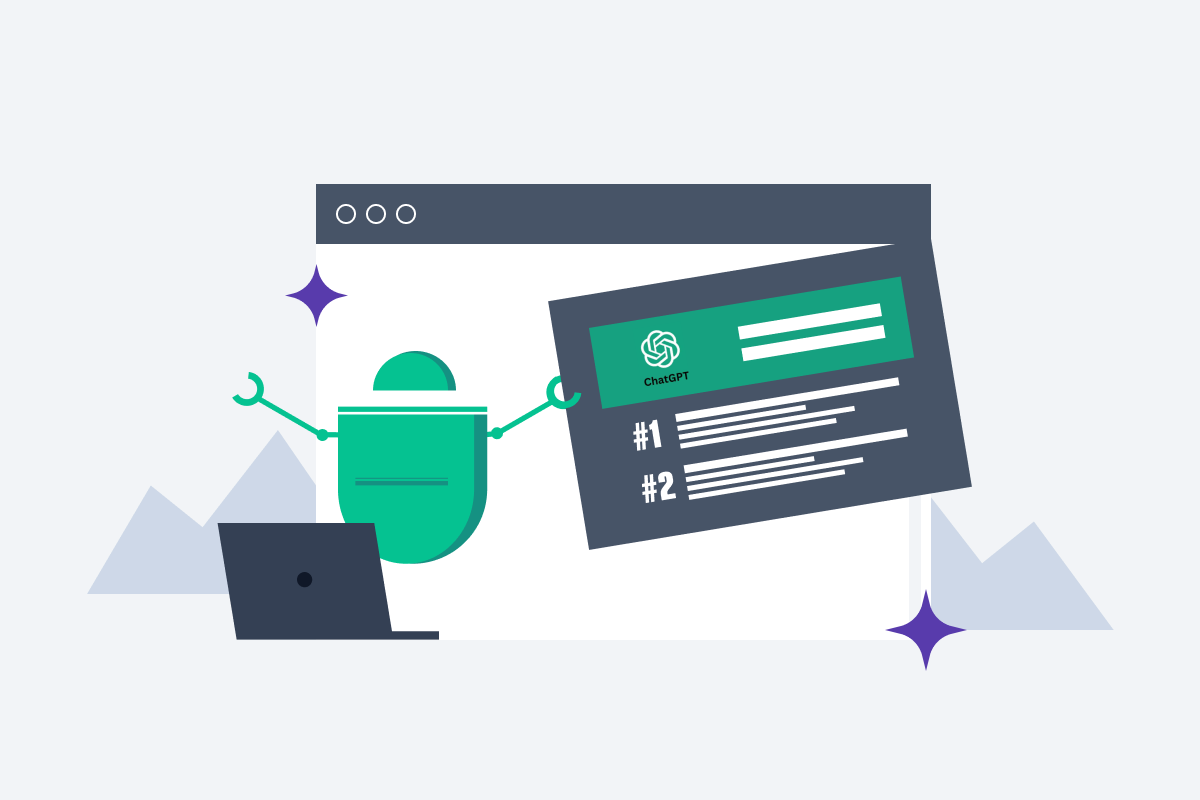Key Takeaways
Welcome to the new reality of searching.
Heading to AI search engines like ChatGPT for answers. Prompting AI to do day-to-day tasks like writing emails. Asking AI relationship advice.
Using AI for everything. With only a single prompt.

Did you know that ChatGPT processes over 1 billion queries daily? This represents a billion times someone chose it over traditional search engines, and has been correlated with a dent in website traffic.
But that’s not all that ChatGPT has enabled: this is also a sign of a core change in the way we perform tasks.
Beyond just advanced searching, LLMs have opened a universe of possibilities, particularly in operations that involve repetition, such as SEO.
This paradigm shift has created the defining paradox of marketing in 2025: the same AI that's stealing your website traffic can become your tool to bring in traffic as well.
In this article, we discuss a dual strategy for SaaS SEO professionals to address both these trends in 2025:
ChatGPT in Search: How you can make the best use of ChatGPT in your SEO strategy (with examples of how we use it at TripleDart)
Search in ChatGPT: How you can adapt to users shifting from search engines to answer engines by getting ranked in ChatGPT
The core of this approach is that AI amplifies rather than replaces strong SEO fundamentals. However, it is very important to be mindful of what AI is good at and what it is not. Given that AI hallucinates and its output is only as effective as the prompt, we need to strike a balance between using and overusing AI.
Let’s dive in.
Understanding the ChatGPT Revolution and GPT-4o
Traditional search trained us to expect a specific, predictable user journey:
Query → Results page → Website visits → Conversions
Optimize for rankings, earn clicks, convert visitors. Sit back and enjoy.
But with LLMs, answers appear without destinations.
When you ask ChatGPT, "What's the best project management tool for remote teams?", you don't get ten blue links to compare. You get a synthesized answer drawing from dozens of sources.
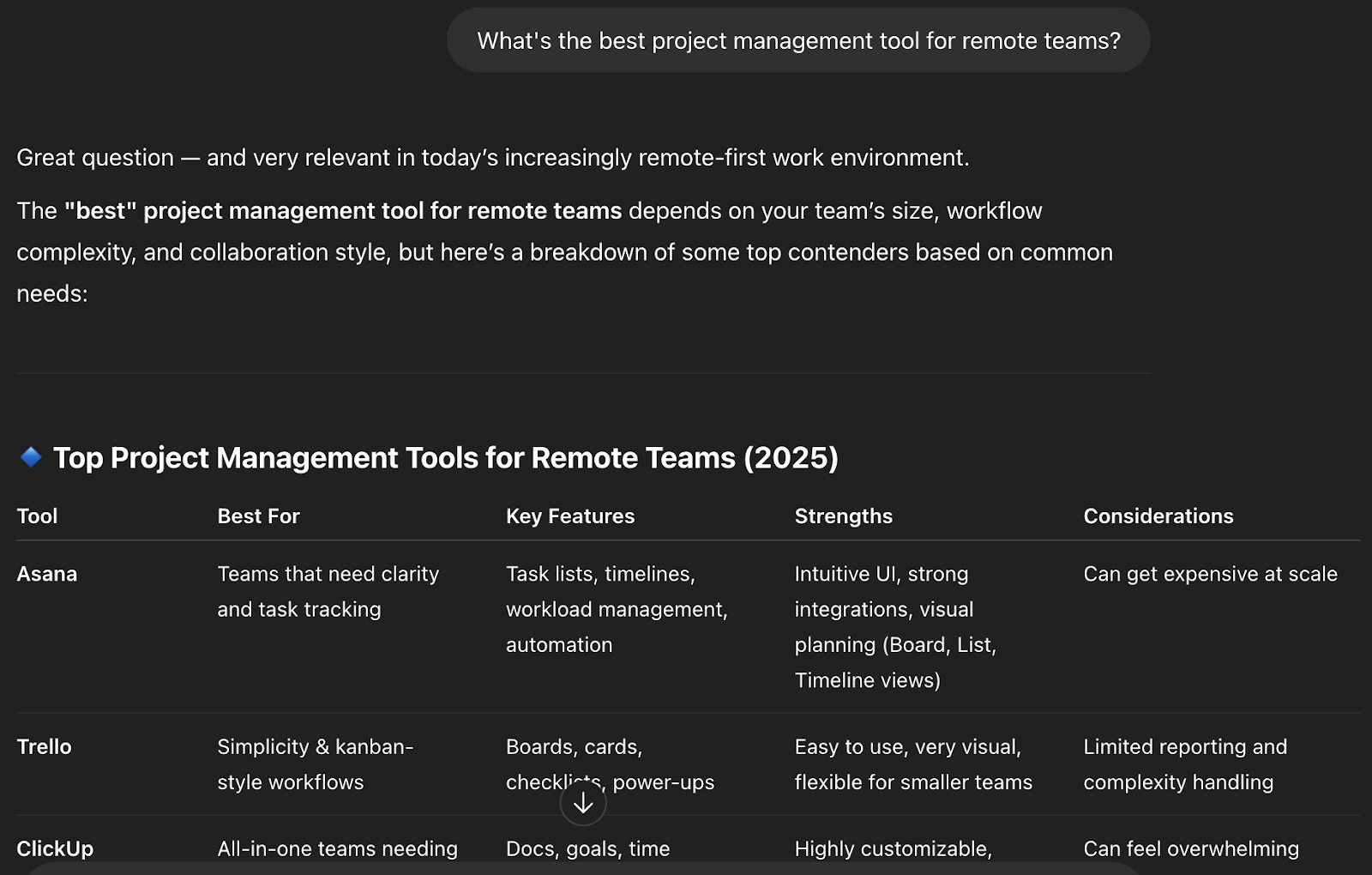
The fact is this: you get this answer in seconds, but the companies (i.e., sources) that provided this underlying information may never know what happened behind the scenes unless they know how AI engines work.
This has given rise to the field of GEO, or Generative Engine Optimization - adapting digital content to rank on AI-driven search engines like ChatGPT.
GEO helps your brand appear in AI-generated results when people search for topics related to your products, services, or expertise, putting you in front of people who are ready to take action.
About GPT-4o
GPT-4o (where “o” for "omni" reflects its multimodal nature) processes text, images, and audio through a single neural network rather than the multiple systems that legacy AI required. This architecture means faster, more contextual responses that mirror human conversation patterns.
GPT-4o's training process involves generative pre-training across text, images, and audio simultaneously. This creates an AI system that understands context across modalities - once that can analyze visual content, understand structures, and generate multimedia responses that consider how information appears across different formats.
And that’s what makes this your ultimate SEO weapon, given that you use it correctly.
Using ChatGPT for Your SEO
Traditional SEO work—keyword research, content briefs, technical optimisation—consists largely of pattern recognition and systematic analysis. This means it fits AI like a glove.
Let’s look at all the ways you can utilize ChatGPT in your SEO operations.
Keyword Research
Consider the bottleneck that keyword research creates for most SaaS content teams: analyzing hundreds of terms, identifying semantic relationships, mapping search intent…this can be a headache. In addition to this, manual work also delays content production.
ChatGPT to the rescue.
ChatGPT is good at performing semantic analysis through pattern recognition: Feed it raw keyword data with instructions to group by intent and semantic similarity, and it identifies relationships that even human analysts might miss.
If you want to go further, export support tickets and customer questions, then prompt ChatGPT to generate the questions your audience actually asks.

There are limitations to this, of course.
ChatGPT can't access search volume data, making it incomplete for commercial validation.
Use ChatGPT to expand your semantic understanding and generate customer insights, then double-check with tools like Ahrefs or Semrush. This way, AI handles the pattern spotting while your traditional tools confirm there's actual money in it.
Content Creation
This is the most instinctive way that people use AI.
Content Briefs
A well-structured brief can really take the quality of an article up several notches and give the writer a sense of direction.
Here are the steps you can ask ChatGPT to follow in order to design your content creation AI workflow:
- Analyze audience pain points and motivations
- Craft strategic product positioning
- Generate SEO-optimized title suggestions
- Create comprehensive FAQs from "People Also Ask" data
- Recommend optimal word count based on competitor analysis
- Build content outlines by comparing top-performing articles
- Suggest internal linking strategies with proper anchor text
When it's done, you get a complete, ready-to-use brief.
An HR tech client, who used to take 2 hours to generate detailed briefs, now uses this workflow and gets the job done in 5-10 minutes!
Meta Title and Description
ChatGPT gives out compelling meta titles and descriptions fast, but they often need some human editing.
The ideal workflow looks like this:
- Extract the current meta title and description from your target pages
- Search and analyze the top 10 competing URLs for the target keyword
- Identify content gaps by comparing your metadata with competitors
- Loop through each competitor URL to analyze their title and description strategies
- Extract key entities and patterns from top-performing meta elements
- Generate optimized meta title and description recommendations
- Provide detailed reasoning behind each suggestion based on competitor analysis
- Output everything in a structured format, ready for implementation
Generating the correct Meta titles and descriptions is a very tricky aspect of SEO, and this workflow that we built lends a huge helping hand with it!
Schema Markup
This basically frees marketing teams from depending on developers.
ChatGPT accurately generates JSON-LD for all 34 Google-supported schema types, with Product, FAQ, and HowTo schemas delivering the most value for SaaS companies.
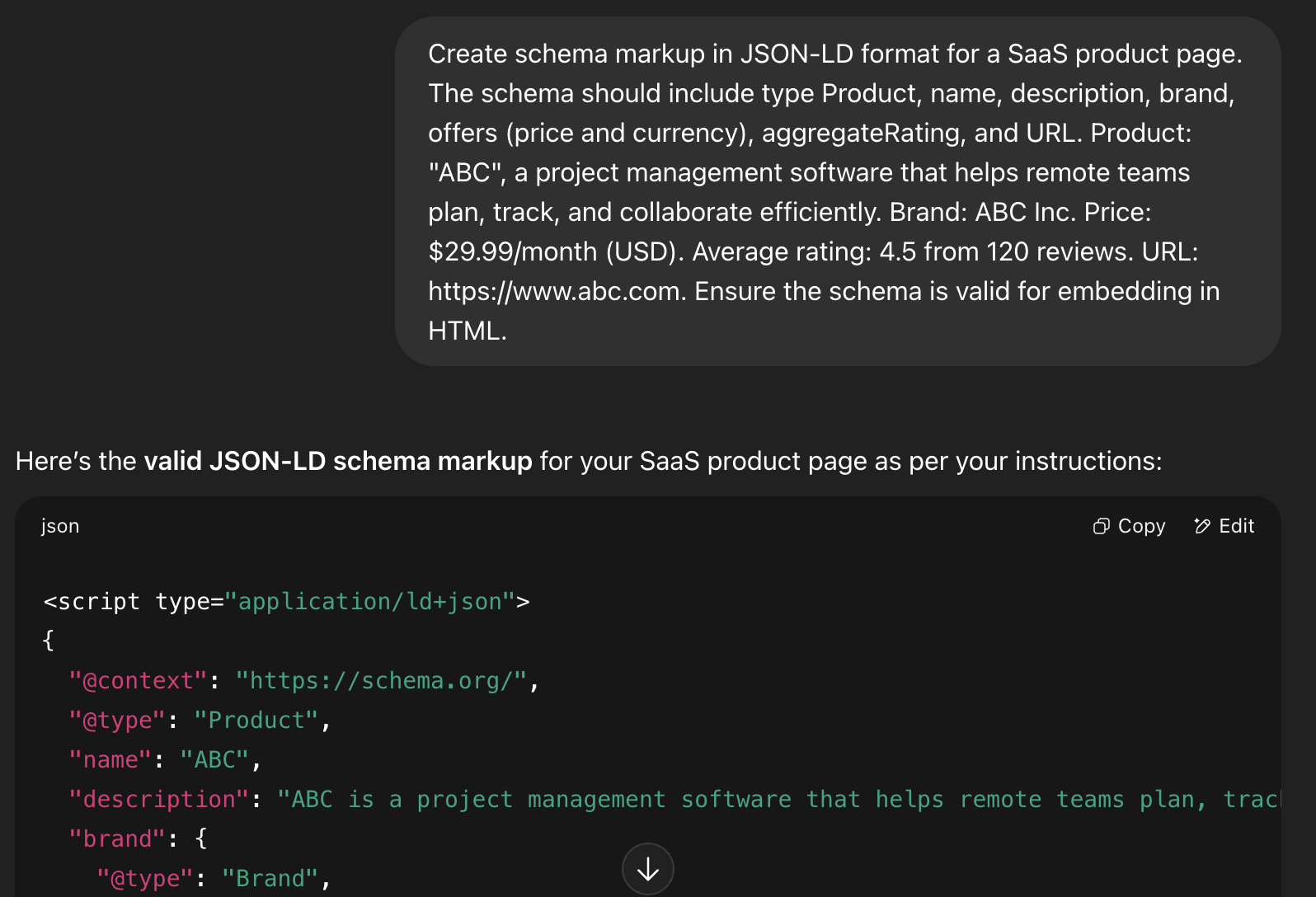
Content Creation
This is a topic of debate, but there’s no denying that ChatGPT, or other AI platforms, haven’t reached full maturity in generating full-blown long-form content.
Where ChatGPT does come in handy the most is in structuring, fact-checking, and correcting the grammar of your draft. ChatGPT can also reproduce smaller sections when given detailed instructions on what to cover and the writing style.
However, given that Google penalizes AI-generated content, it is generally advised not to depend fully on ChatGPT for content writing, at least for now!
Technical SEO
All those technical SEO tasks that used to need specialists are accessible to marketing teams, with ChatGPT coming into the picture.
For example, take RegEx pattern creation for GA4 analytics. Tracking AI traffic from ChatGPT, Claude, and Gemini usually needs RegEx skills that most marketers don't have, which means waiting for the tech team.
ChatGPT generates these patterns instantly, though teams must validate for RE2 compliance through testing.
International SEO optimization
This also becomes more accessible through AI assistance.
Ahrefs data shows 67% of sites implement hreflang incorrectly, creating missed opportunities in global markets. ChatGPT pretty much eliminates this by creating complete hreflang tags when you give it your URL structure and target languages.

Internal linking optimization
AI can identify opportunities human editors could miss (and vice versa).
ChatGPT looks at how your content connects and suggests links that improve both your site structure and user experience.
For example, we created a Backlink Audit Workflow that saves hours of manual link analysis.
Here’s how it works:
- Inputs: CSV file of backlink domains + brand kit with your niche and criteria
- Smart Analysis: Scrapes each backlink URL to gather contextual signals and quality indicators
- AI-Powered Evaluation: Uses trained LLM prompts to identify spam signals vs. positive ranking factors
- Scales Effortlessly: Whether you have 10 or 10,000 backlinks, each gets individual analysis
- Clear Decisions: Outputs structured lists of URLs to keep vs. disavow with detailed justifications
- Actionable Results: Get exact removal recommendations plus reasoning for confident decision-making
What used to take our content team hours of analysis is now done in minutes!
Competitive Edge
AI turns competitive analysis from a time-consuming research project into a systematic advantage. Sample these cases:
- Link building outreach sees immediate improvements when ChatGPT personalizes communications at scale.
- Generic templates get low response rates, but AI-generated personalized emails work much better by pulling in details about the target site and creating authentic partnership pitches.
- ChatGPT makes content gap analysis systematic instead of manual—it compares competitor content to what you have and spots what you're missing.
This ensures competitive coverage while reducing the manual work that delays response to market changes.
Optimizing for ChatGPT Citations
Now we come to the second part of this guide: getting ranked in AI answer engines, or Generative Engine Optimization.
Productivity gains are great, but optimizing for AI citations is where you build long-term competitive advantages that keep growing.
Since ChatGPT sends way more converting traffic, SEO teams need to focus on getting their content and brand ranked in ChatGPT.
And here are some research-backed methods that can help you with it.
Understanding the Audience
GEO starts with figuring out exactly what questions your audience asks and how they actually phrase them
Use tools like Ahrefs, AnswerThePublic, and AlsoAsked to identify common query patterns related to your product or industry. These tools reveal the natural language questions users ask, going beyond what keyword tools suggest they might ask.
Dig into 'People Also Ask' sections—they're getting more prominent and show exactly what Google thinks users want to know.
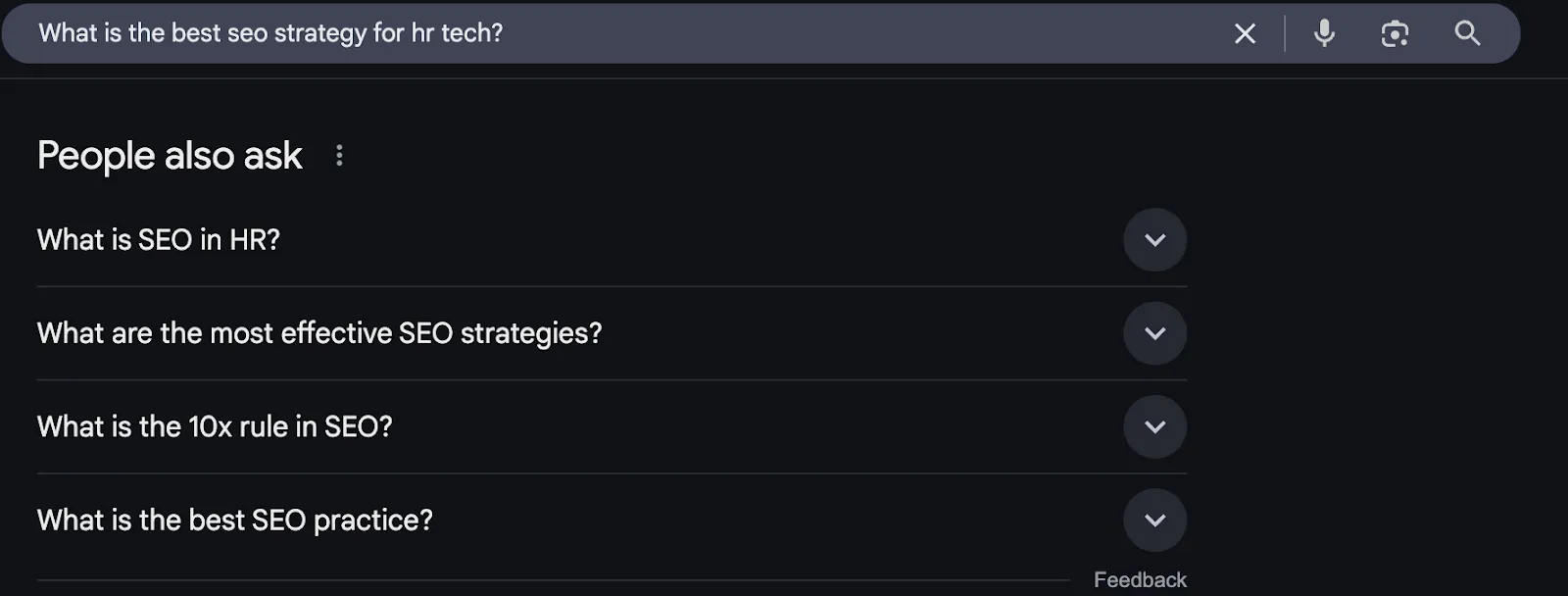
Create Answer-First Content Architecture
AI systems don't read content linearly like humans browsing websites. Instead, they scan for meaning, clear structure, and quotable content.
Start with direct answers, giving the main response in 1-2 sentences right up front, where AI will spot it.

Follow with bulleted key points, then detailed paragraphs. This works for both humans looking for quick answers and AI systems hunting for quotable content.
Enhance Content Structure
Here are four ways you can improve your content structure:
- Create bite-sized, snippet-ready content that gives direct, actionable answers.
- Focus on FAQs, summaries, and step-by-step guides: stuff AI can easily quote while still covering everything in your longer content.
- Use bullet points, numbered lists, and summary boxes (they help both human readers and AI systems.)
- Convert feature comparisons, pricing tiers, and benchmark data into proper HTML tables rather than paragraph descriptions. These pages rank better and get cited by AI more often.

Prioritize Language Clarity and Accuracy
Using easy-to-understand language, unique terminology, and maintaining technical accuracy can act as primary ranking factors for AI systems.
Citation quality gets evaluated on how well your content answers specific questions and contributes useful, unique information to AI responses. For this, we need to ensure all information remains factually supported and clearly presented, avoiding ambiguity that might confuse AI—and a human, of course.
Basically, this is a move that prioritizes reader comprehension over search engine manipulation.
Goodbye, keyword stuffing.
Implement Schema Markup
Schema markup was always useful, but it just isn't optional anymore:
Match schema to content purpose by selecting appropriate types based on content structure:
- FAQ schema for grouped questions
- How-To schema for procedural guidance
- Q&A schema for individual questions
Use JSON-LD format (Google's preferred approach) and test it with Schema.org Validator and Google's Rich Results Test.
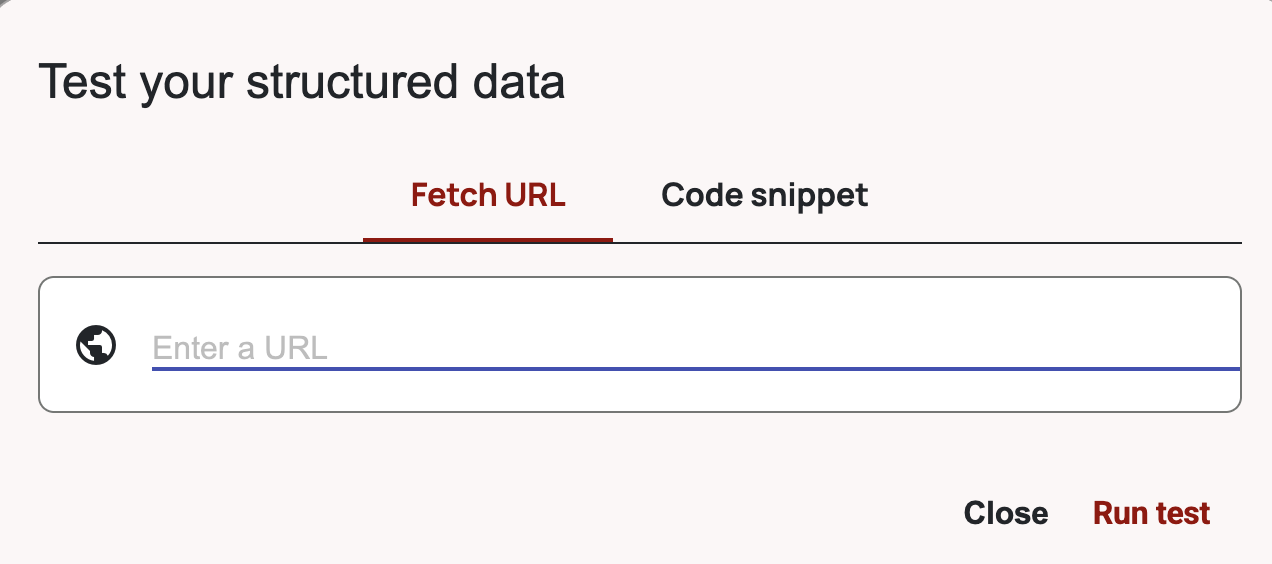
Technical Infrastructure for AI Parsing
Smart headers boost AI visibility by helping AI understand your content better and not just hit keywords.
Pages with semantically similar H1s have higher correlation with ChatGPT mentions, meaning rewriting headers to match natural question patterns is better than just having a keyword in it.
Mobile experiences are prioritised by AI - they indicate how quickly your content loads and displays properly across devices.
Here’s where E-E-A-T signals (experience, expertise, authoritativeness, trustworthiness) come in: pages demonstrating these qualities are more likely to receive citations.
Some examples of this: named authors with verifiable credentials, actual product screenshots, and specific case studies with concrete metrics rather than generic success stories.

Build Topic Authority
Individual page optimization only creates foundational visibility.
There’s a next step to it.
AI systems reward comprehensive topic coverage that demonstrates expertise across entire subject areas.
Create hubs around each major feature or use case, with each piece contributing unique value while supporting broader topic authority.

Develop Persona-Specific Content Systems
Create content for specific personas that anticipates different user questions, including long-tail queries that don't show up in search volume but pop up frequently in AI conversations.
This taps into AI's strength in personalization through tailored responses based on what users ask.
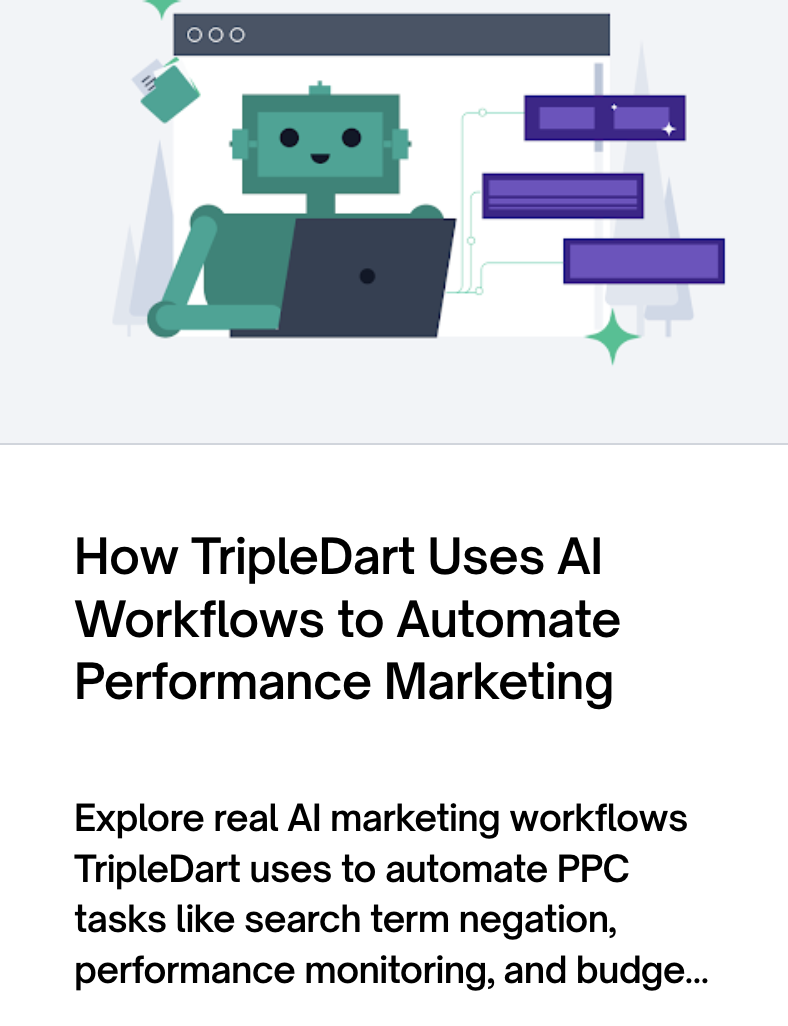
This makes your brand a go-to information source for AI tools, letting you catch the user’s attention even when they don't visit your website.
External Validation
External validation impacts how AI systems assess your credibility beyond your owned properties.
Get high-quality mentions by earning citations in authoritative industry publications, expert roundups, and respected review sites. Quotable material, like data and statistics, proves particularly valuable for these external signals that influence AI trust assessments.
Expand thought leadership by participating in industry podcasts, webinars, and conferences to build recognition signals that extend beyond your owned properties. This highlights both company expertise and team member credentials, creating multiple trust signals that reinforce your authority.
Distribute to the Answer Ecosystem
Getting your content in the right places means you'll get quoted more often across different AI platforms.
- Engage with AI-visible communities by participating in platforms like Reddit, Stack Overflow, and industry forums that frequently appear in AI training data and influence citation decisions.
- Optimize your technical resources by making sure documentation, APIs, and developer resources are fully crawlable and accessible to AI systems.
- Prioritize natural discovery by focusing on creating inherently discoverable content rather than relying on manual submission processes that don't scale effectively.
This approach gets your content into all the places AI systems look when creating answers, boosting your chances of getting quoted across different platforms and building visibility in the AI ecosystem.
Essential Tools: ChatGPT Extensions for Marketing Teams
These two tools can help in transforming ChatGPT from a helpful assistant into a marketing platform that maintains more consistency.
AIPRM
AIPRM solves the consistency problem that stops teams from scaling up their AI use. Its pre-built prompt library cuts out the learning curve and keeps quality consistent across your team.

For remote SaaS marketing teams, especially, AIPRM's custom templates fix the brand consistency issues that pop up when everyone uses AI differently.
Marketing managers can build templates that bake in their brand voice, content standards, and SEO best practices. New writers can nail their brand voice right away, while seasoned team members can save hours on routine stuff!
WebChatGPT
WebChatGPT fixes ChatGPT's biggest weakness for marketing teams—its outdated training data.
With real-time web access, WebChatGPT turns ChatGPT from a static knowledge bank into a live research assistant that grabs current info.
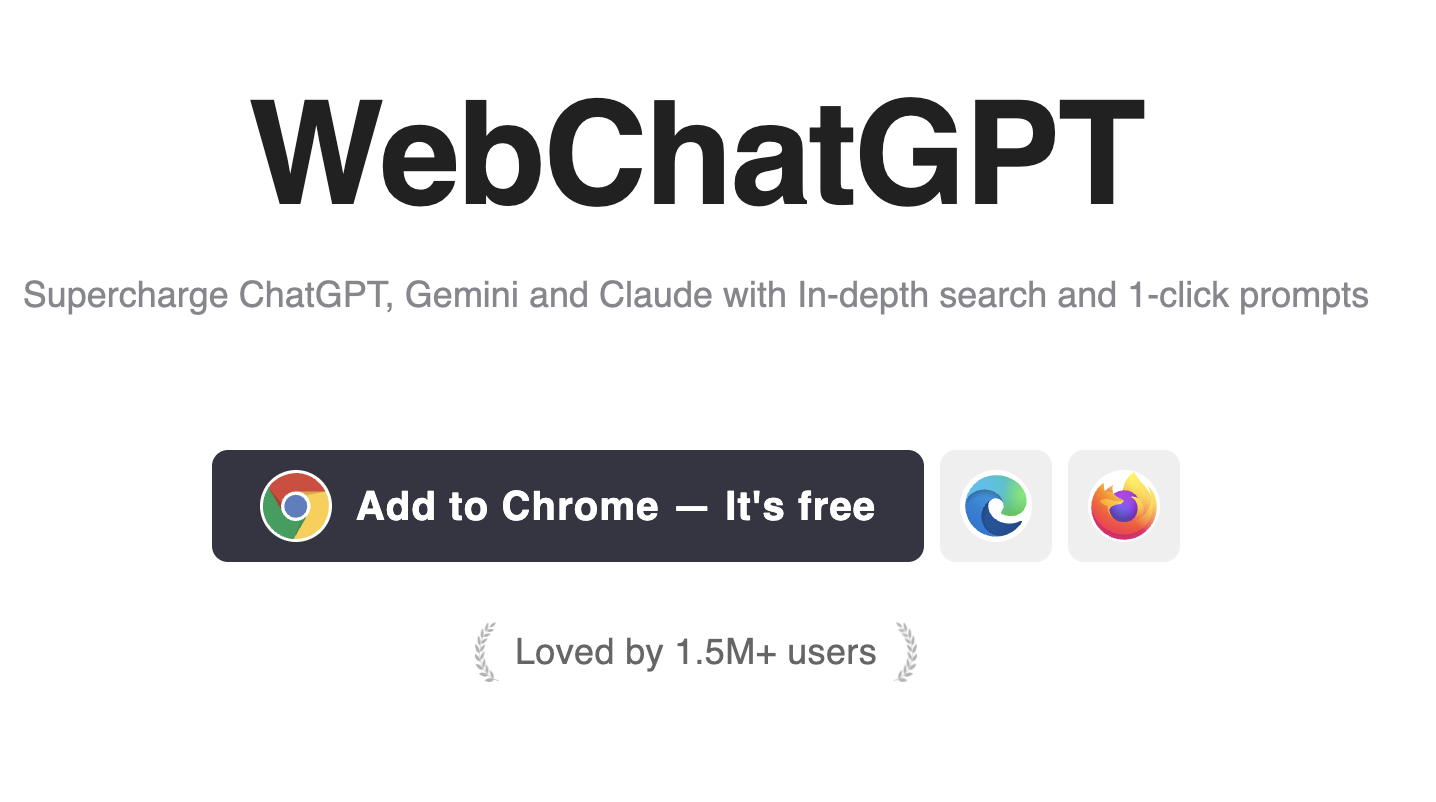
This is very helpful for SaaS marketing teams doing competitive intelligence.
Understanding Critical Limitations
ChatGPT can transform your strategy, but it has limitations that'll derail things if you ignore them. Apart from commonly known issues like hallucinating, sourcing of information, and relevance of outputs, here are some specifics to keep in mind:
Understanding ChatGPT's limits prevents expensive mistakes that waste resources or hurt your brand. ChatGPT is great at spotting patterns, generating basic content, and automating technical tasks, but it can't access real-time data without extensions, provide proprietary insights, or replace expertise.
And here's the big limitation for SEO teams: ChatGPT can't access search volume data, so you still need traditional keyword tools to validate demand.
Without extensions, it lacks current information and might give outdated recommendations that hurt your competitive position. Most importantly, it cannot replace human judgment on strategy, brand voice, or compliance requirements in regulated industries.
AI Traffic Attribution
Traditional SEO metrics like rankings, traffic, and conversions are still important, but they don't tell the full AI marketing story.
To see AI traffic clearly, you need to reconfigure your analytics. Start with custom GA4 channel groupings that separate AI referrals from traditional organic traffic. Use ChatGPT-generated regex patterns to identify sessions from different AI platforms and track this new traffic source properly.

Here's the systematic approach: create regex patterns for AI referrers, set up custom GA4 channels, and build dashboards showing AI traffic next to traditional metrics.
Key AI SEO metrics extend beyond simple volume measurements to capture the unique value AI traffic provides. Track citation rate (mentions per piece of content), citation quality (whether mentions include links back to source), and engagement patterns from AI-referred visitors.
Conclusion
With Gartner predicting that 25% of search volume will shift away from traditional search engines by 2026, companies face a binary choice: adapt quickly to build competitive advantages or watch competitors establish leads.
Human expertise remains irreplaceable in this AI-augmented future, but the relationship between human creativity and AI capability continues evolving. ChatGPT amplifies human capabilities without replacing strategic thinking, brand understanding, or quality judgment.
TripleDart specializes in helping SaaS companies with their GEO strategy. We’ve helped several companies find their footing with ranking in AI engines, as well as adapting to the AI era.
If you want to see how TripleDart's GEO services can help you capture the full potential of AI-driven search, head to our GEO page and book a call!
Frequently Asked Questions (FAQs)
Can ChatGPT replace traditional SEO tools?
ChatGPT is an excellent complement to traditional SEO tools, but it cannot fully replace them. While it excels at pattern recognition, content structuring, and automating repetitive tasks, it lacks access to key SEO data such as search volume. Combining ChatGPT with human oversight and tools like Ahrefs or Semrush ensures a well-rounded SEO strategy.
What are the best ChatGPT prompts for SEO?
Effective ChatGPT prompts for SEO include generating content briefs, creating SEO-optimized meta titles and descriptions, conducting keyword analysis by intent, and generating schema markup. Prompts should be specific to maximize results, such as "Create an SEO content brief for [topic] using audience pain points."
How do I optimize my content to rank in ChatGPT search results?
To rank in ChatGPT, focus on creating clear, structured, answer-first content. Start with concise, direct answers followed by supporting details. Use bullet points, FAQs, and schema markup to enhance readability and ensure your content is quotable for AI systems, boosting visibility.
Is ChatGPT-generated content good for SEO?
While ChatGPT can be valuable for content creation, its output requires human review. AI-generated content can enhance the structure and grammar of your drafts, but it should be fact-checked and aligned with SEO best practices. Over-reliance on AI for long-form content may lead to penalties.
What's the difference between using ChatGPT for SEO vs. optimizing for ChatGPT?
Using ChatGPT for SEO involves leveraging its capabilities to automate tasks like keyword research, content creation, and technical SEO. Optimizing for ChatGPT, on the other hand, focuses on structuring your content so it ranks well in AI-driven search engines by ensuring it’s clear, quotable, and relevant to user queries.
Related Posts
We'd Love to Work with You!
Join 70+ successful B2B SaaS companies on the path to achieving T2D3 with our SaaS marketing services.

.png)
.png)


%20Agencies%20(2025).png)
![Top 11 AI SEO Content Generators for 2025 [Ranked & Reviewed]](https://cdn.prod.website-files.com/632b673b055f4310bdb8637d/6858e2c2d1f91a0c0a48811a_ai%20seo%20content%20generator.webp)


